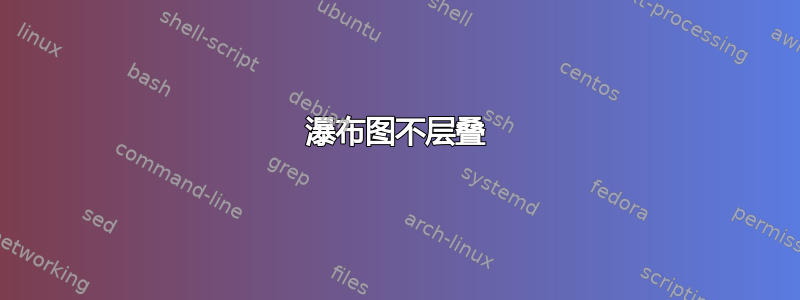
这是 MWE
\documentclass[border=5mm]{standalone}
\usepackage{pgfplots, pgfplotstable}
\usepackage{filecontents}
\pgfplotsset{compat=1.5.1}
\begin{filecontents}{datatable.csv}
27 47
12 21
39 69
12 17
17 23
67 69
\end{filecontents}
\pgfplotstableset{
create on use/accumyprev/.style={
create col/expr={\prevrow{0}+\prevrow{1}+\pgfmathaccuma}
}
}
% Style for centering the labels
\makeatletter
\pgfplotsset{
centered nodes near coords/.style={
calculate offset/.code={
\pgfkeys{/pgf/fpu=true,/pgf/fpu/output format=fixed}
\pgfmathsetmacro\testmacro{(\pgfplotspointmeta*10^\pgfplots@data@scale@trafo@EXPONENT@y)/2*\pgfplots@y@veclength)}
\pgfkeys{/pgf/fpu=false}
},
every node near coord/.style={
/pgfplots/calculate offset,
yshift=-\testmacro,
black,
font=\scriptsize,
},
nodes near coords align=center
}
}
\makeatother
\begin{document}
\begin{tikzpicture}
\begin{axis}[
width = 0.85*\textwidth,
height = 8cm,
no markers,
ybar stacked,
bar width = 20pt,
ymin=0,
point meta=explicit,
centered nodes near coords,
axis lines*=left,
xtick=data,
major tick length=0pt,
xticklabels={
2014\\ GDP,
Business \\as \\ usual \\growth,
Total \\2025 \\ business-\\as-usual \\l GDP,
Increm-\\ental \\ best-\\in-region\\ GDP\\ in 2025,
additional\\ GDP \\ in full\\-potential \\ scenarios in\\ 2025,
Total \\2025\\ business-\\as-usual\\ GDP,
},
xticklabel style={font=\small, text width=4cm, align=center},
enlarge x limits=-0.85,
ytick=\empty,
y axis line style={opacity=0},
ylabel style={font=\small},
axis on top
]
% The first plot sets the "baseline": Uses the sum of all previous y values, except for the last bar, where it becomes 0
\addplot +[
y filter/.code={\ifnum\coordindex>2 \def\pgfmathresult{0}\fi},
draw=none,
fill=none
] table [x expr=\coordindex, y=accumyprev] {datatable.csv};
% The lower bound
\addplot +[
fill=orange,
draw=orange,
ybar stacked,
nodes near coords
] table [x expr=\coordindex, y index=0, meta index=0] {datatable.csv};
% The upper bound
\addplot +[
ybar stacked,
draw=orange!50,
fill=orange!50,
nodes near coords
] table [x expr=\coordindex, y index=1, meta index=1] {datatable.csv};
% The connecting line. Uses a bit of magic to typeset the ranges
\addplot [
const plot, black,
point meta={
TeX code symbolic={
\pgfkeys{/pgf/fpu/output format=fixed}
\pgfmathtruncatemacro\upperbound{
\thisrowno{0} + \thisrowno{1}
}
\edef\dostuff{
\noexpand\def\noexpand\pgfplotspointmeta{%
\thisrowno{0}--\upperbound%
}
}%
\dostuff
}
},
nodes near coords=\pgfplotspointmeta,
every node near coord/.style={
font=\scriptsize,
anchor=south
},
] table [x expr=\coordindex, y expr=0] {datatable.csv};
\end{axis}
\end{tikzpicture}
\end{document}
答案1
顺便说一句,如果你提到你从哪里得到这个,那就太好了瀑布图。我认为,只有两件事是错误的。
数据文件中的最后一行应该是以上各行的总和,所以
107 177,而不是61 69。在第一个图中,您有一个
\ifnum\coordindex>2应该更改为的\ifnum\coordindex>4。\coordindex从零开始计数,并且您希望最后一条线的基线为 0,而不是累积和。
我还将enlarge x limits设置更改为enlarge x limits={abs=0.5}。
\documentclass[border=5mm]{standalone}
\usepackage{pgfplotstable}
\usepackage{filecontents}
\pgfplotsset{compat=1.5.1}
\begin{filecontents}{datatable.csv}
27 47
12 21
39 69
12 17
17 23
107 177
\end{filecontents}
\pgfplotstableset{
create on use/accumyprev/.style={
create col/expr={\prevrow{0}+\prevrow{1}+\pgfmathaccuma}
}
}
% Style for centering the labels
\makeatletter
\pgfplotsset{
centered nodes near coords/.style={
calculate offset/.code={
\pgfkeys{/pgf/fpu=true,/pgf/fpu/output format=fixed}
\pgfmathsetmacro\testmacro{(\pgfplotspointmeta*10^\pgfplots@data@scale@trafo@EXPONENT@y)/2*\pgfplots@y@veclength)}
\pgfkeys{/pgf/fpu=false}
},
every node near coord/.style={
/pgfplots/calculate offset,
yshift=-\testmacro,
black,
font=\scriptsize,
},
nodes near coords align=center
}
}
\makeatother
\begin{document}
\begin{tikzpicture}
\begin{axis}[
width = 0.85*\textwidth,
height = 8cm,
no markers,
ybar stacked,
bar width = 20pt,
ymin=0,
point meta=explicit,
centered nodes near coords,
axis lines*=left,
xtick=data,
major tick length=0pt,
xticklabels={
2014\\ GDP,
Business \\as \\ usual \\growth,
Total \\2025 \\ business-\\as-usual \\l GDP,
Increm-\\ental \\ best-\\in-region\\ GDP\\ in 2025,
additional\\ GDP \\ in full\\-potential \\ scenarios in\\ 2025,
Total \\2025\\ business-\\as-usual\\ GDP,
},
xticklabel style={font=\small, text width=4cm, align=center},
enlarge x limits={abs=0.5},
ytick=\empty,
y axis line style={opacity=0},
ylabel style={font=\small},
axis on top
]
% The first plot sets the "baseline": Uses the sum of all previous y values, except for the last bar, where it becomes 0
\addplot +[
y filter/.code={\ifnum\coordindex>4 \def\pgfmathresult{0}\fi},
draw=none,
fill=none
] table [x expr=\coordindex, y=accumyprev] {datatable.csv};
% The lower bound
\addplot +[
fill=orange,
draw=orange,
ybar stacked,
nodes near coords
] table [x expr=\coordindex, y index=0, meta index=0] {datatable.csv};
% The upper bound
\addplot +[
ybar stacked,
draw=orange!50,
fill=orange!50,
nodes near coords
] table [x expr=\coordindex, y index=1, meta index=1] {datatable.csv};
% The connecting line. Uses a bit of magic to typeset the ranges
\addplot [
const plot, black,
point meta={
TeX code symbolic={
\pgfkeys{/pgf/fpu/output format=fixed}
\pgfmathtruncatemacro\upperbound{
\thisrowno{0} + \thisrowno{1}
}
\edef\dostuff{
\noexpand\def\noexpand\pgfplotspointmeta{%
\thisrowno{0}--\upperbound%
}
}%
\dostuff
}
},
nodes near coords=\pgfplotspointmeta,
every node near coord/.style={
font=\scriptsize,
anchor=south
},
] table [x expr=\coordindex, y expr=0] {datatable.csv};
\end{axis}
\end{tikzpicture}
\end{document}



